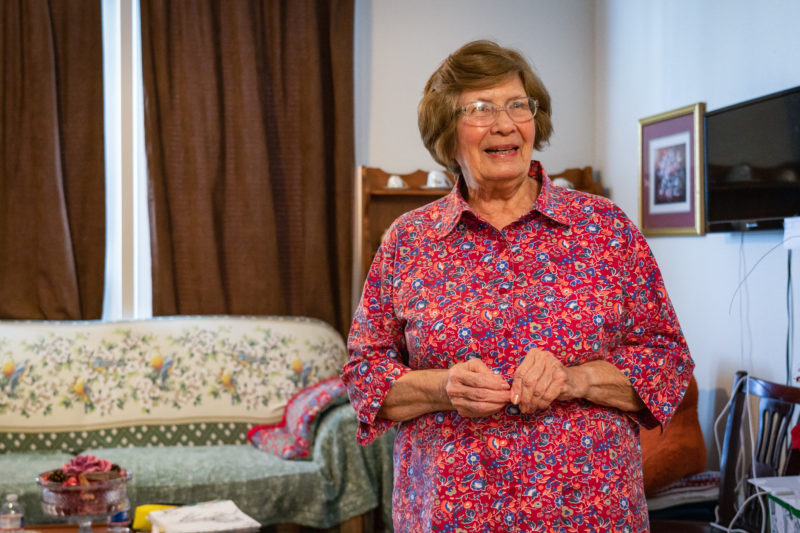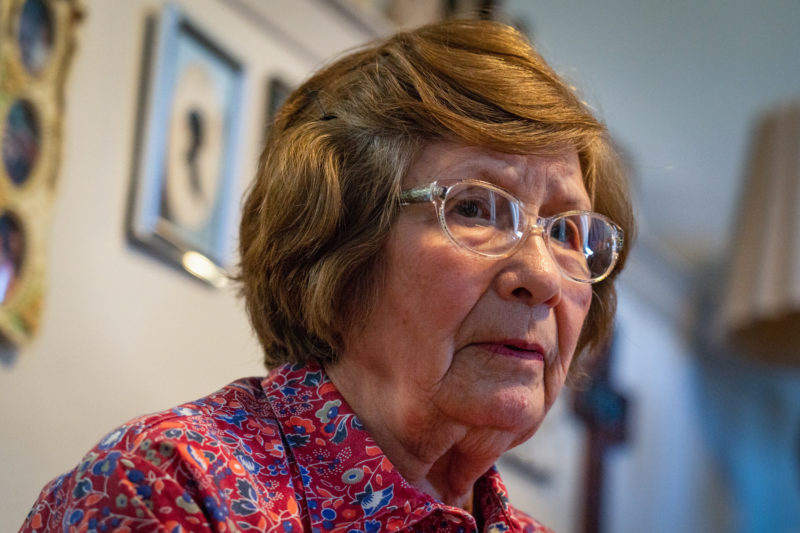With $250 Million Housing Bond on Ballot, a Look at Austin’s Past Housing Bonds
By Christopher De Los Santos
Reporting Texas

Rose Vasquez in her studio apartment in Aldrich 51, located in the Mueller neighborhood in east Austin. Francisco Uribe/Reporting Texas.
On an evening in late October, 80-year-old grandmother Rose Vasquez gazed out the windows of her third-story studio apartment in the Mueller neighborhood.
“I love the view from these windows — the trees, the grass, the sky, especially in the mornings and evenings,” Vasquez said. “I really am grateful to live here.”
Vasquez said she likes many things about her home — the dedicated apartment management staff and the fact her neighbors are a wide range of ages.
Vasquez pays about $400 a month, well below the market rate, for her unit in the Aldrich 51 apartment complex. The majority of the 240 apartments in the complex are reserved for people earning between 30 and 60 percent of Austin’s median income, which is between $18,200 and $36,120 a year for a single person. The construction of Aldrich 51 was made possible in part by a $65 million housing bond passed by Austin voters in 2013.
The 2013 bond was the largest of its kind at the time, surpassing a $55 million housing bond passed in 2006. When voters go to the polls on Nov. 6, they will be asked to approve another affordable housing bond, one with a much bigger price tag — $250 million.
Some opponents of the bond, including City Council Member Ellen Troxclair, say it doesn’t address what they see as drivers of high housing costs: long wait times for building inspections, building restrictions and expensive construction permits. “It is really not addressing problems we are trying to solve,” Troxclair said.
Supporters say the bond is necessary because Austin’s skyrocketing housing costs make it difficult for working families to afford to live in the city.
The bond, dubbed Proposition A on this year’s ballot, calls for $100 million for land purchases, $94 million to develop low-income rental housing, $28 million for a home repair program and $28 million for a home ownership program. To help voters make an informed decision about the big-ticket bond, Reporting Texas took a look at the city’s last two housing bonds.
The 2013 Housing Bond
The city presented a proposition for a $65 million housing bond in 2013 as a way to help low-income families have an affordable place to live through rental assistance, a home ownership program and home repair assistance. The city leveraged the $65 million in funds with an additional $436 million in grants from public and private sources to refurbish and build more than 1,400 housing units.
The city awarded almost $17 million to the nonprofit Foundation Communities to build and maintain seven apartment complexes with 544 apartment units collectively. Foundation Communities builds and manages apartment communities with onsite social workers, after-school programs and other assistance, for residents earning 50 percent or less of Austin’s median family income.
The city allotted approximately $10 million in to commercial developer Diana McIver and Associates, to build four apartment communities. Diana McIver and Associates built 432 affordable housing unit for families earning 50 percent or less of Austin’s median family income, including Aldrich 51, where Rose Vasquez lives.

Vasquez has lived at Aldrich 51 since December 2017, shortly after construction on the project was completed. Francisco Uribe/Reporting Texas.
The city also set aside almost $12 million of the 2013 bond funds for grants to organizations performing maintenance and repairs on housing for disabled, elderly and other qualifying residents.
The home repair program of Meals on Wheels Central Texas transformed the homes of dozens of elderly and disabled Austinites because of the 2013 bonds, said Adam Hauser, president of Meals on Wheels Central Texas. Repairs included safety and mobility features and routine maintenance, such as replacing roofs and floors.
The remaining $36 million from the 2013 bond went to 15 developers of smaller rental projects, including Habitat for Humanity and the Chestnut Neighborhood revitalization corporation, for down payment assistance and home ownership programs.
The 2006 Housing Bond
The city’s 2006 housing bond totaled $55 million and was used to build and renovate more than 2,500 housing units for low-income residents. For every dollar raised through the bond issue, the city secured $4 from public and private grants. In all, the housing improvements cost $261 million.
“[The 2006] bonds have created thousands of much-needed affordable housing units in our city,” said Nora Linares-Moeller, executive director of the nonprofit HousingWorks Austin.
The city gave Foundation Communities more than $10 million to build or refurbish six apartment communities with 521 affordable housing units collectively. Another nonprofit, Green Doors, received $4.4 million to build or refurbish four apartment communities with a total of 123 affordable housing units.
The city awarded Habitat for Humanity $2.5 million to build 74 homes to be owned by families earning 80 percent of the city’s median income. The Chestnut Neighborhood Development Corporation received $1.4 million to refurbish 33 homes.
The remaining $36.7 million went to 10 developers of smaller rental projects.
The 2006 and 2013 bonds didn’t end the affordable housing problem in Austin, but they were a step in the right direction, Linares-Moeller said.
Aldrich 51 apartment manager Blake Mauldin said he’s hopeful that voters will approve the city’s new $250 million housing bond.

Portrait of Vasquez in her home on Oct. 29, 2018. Francisco Uribe/Reporting Texas.
“If the voters approve Proposition A, that will really help us and all the other affordable housing providers to serve more deserving residents, like Rose,” Mauldin said.